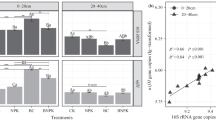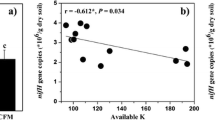Abstract
Diazotrophs carry out biological nitrogen (N) fixation process that replenishes available soil N; it is unclear how soil diazotrophic communities respond to biochar and chemical fertilizer amendment in agricultural ecosystem. Herein, we studied the impacts of biochar and chemical fertilizer amendment on diazotrophic communities in rhizosphere and bulk soils using nifH gene. The field experiment included four treatments: control (CK), biochar (B), chemical NPK fertilizer (CF), and biochar + chemical fertilizer (B + CF). nifH gene abundance in rhizosphere soils ranged from 9.00 × 107 to 2.57 × 108 copies g−1 dry soil among the different treatments, which was 1.42–2.68 times higher compared with the bulk soils ranging from 5.83 × 107 to 1.19 × 108 copies g−1 dry soil. Single application of biochar increased the abundance of nifH gene, whereas chemical fertilizer addition significantly decreased it in the bulk and rhizosphere soils. Single biochar addition affected diazotrophic community composition in rhizosphere soil, but not in the bulk soil. However, both CF and B + CF treatments obviously changed the community structure of diazotrophs in both soils. Moreover, rhizosphere effect enhanced nifH gene abundance and significantly altered the diazotrophic community structure compared to bulk soil. Phylogenetic analysis showed that all nifH sequences were affiliated to the cyanobacteria, α-, β-, γ-, and δ- subclasses of the proteobacteria group. Soil nutrient availability rather than pH had significant impacts on diazotrophic community structure based on mantel test and redundancy analysis. Overall, biochar improves the diazotrophic abundance, while chemical fertilization negatively affects it by altering nutrient availability, and combined application of biochar and chemical fertilizer does not counteract the adverse influences of chemical fertilizer on nitrogen-fixing microorganisms.




Similar content being viewed by others
Data availability
All datasets generated for this study are included in the article.
References
Calderoli PA, Collavino MM, Kraemer FB, Morras HJM, Aguilar OM (2017) Analysis of nifH-RNA reveals phylotypes related to Geobacter and Cyanobacteria as important functional components of the N2-fifixing community depending on depth and agricultural use of soil. Microbiol Open 6(5):e00502. https://doi.org/10.1002/mbo3.502
Cao H, Jia M, Xun M, Wang X, Chen K, Yang H (2021) Nitrogen transformation and microbial community structure varied in apple rhizosphere and rhizoplane soils under biochar amendment. J Soils Sediments 21:853–868. https://doi.org/10.1007/S11368-020-02868-W
Cayuela ML, van Zwieten L, Singh BP, Jeffery S, Roig A, Sánchez-Monederoa MA (2014) Biochar’s role in mitigating soil nitrous oxide emissions: a review and meta-analysis. Agri Ecosyst Environ 191:5–16. https://doi.org/10.1016/j.agee.2013.10.009
Chen J, Liu X, Li L, Zheng J, Qu J, Zheng J, Zhang X, Pan G (2015) Consistent increase in abundance and diversity but variable change in community composition of bacteria in topsoil of rice paddy under short term biochar treatment across three sites from South China. Appl Soil Ecol 91:68–79. https://doi.org/10.1016/j.apsoil.2015.02.012
Chen L, Li K, Shi W, Wang X, Wang E, Liu J, Sui X, Mi G, Tian C, Chen W (2021) Negative impacts of excessive nitrogen fertilization on the abundance and diversity of diazotrophs in black soil under maize monocropping. Geoderma 393:114999. https://doi.org/10.1016/J.GEODERMA.2021.114999
Cleveland CC, Townsend AR, Schimel DS, Fisher H, Howarth RW, Hedin LO, Perakis SS, Latty EF, Von Fisher JC, Elseroad A, Wasson MF (1999) Global patterns of terrestrial biological nitrogen(N2) fixation in natural ecosystems. Global Biogeochem Cy 13:623–645. https://doi.org/10.1029/1999GB900014
Collavino MM, James Tripp H, Frank IE, Vidoz ML, Calderoli PA, Donato M, Zehr JP, Mario Aguilar O (2014) nifH pyrosequencing reveals the potential for location-specific soil chemistry to influence N2-fixing community dynamics. Environ Microbiol 16:3211–3232. https://doi.org/10.1111/1462-2920.12423
Ducey TF, Ippolito JA, Cantrell KB, Novak JM, Lentz RD (2013) Addition of activated switch grass biochar to an aridic subsoil increases microbial nitrogen cycling gene abundances. Appl Soil Ecol 65:65–72. https://doi.org/10.1016/j.apsoil.2013.01.006
Elzobair KA, Stromberger ME, Ippolito JA, Lentz RD (2016) Contrasting effects of biochar versus manure on soil microbial communities and enzyme activities in an Aridisol. Chemosphere 142:145–152. https://doi.org/10.1016/j.chemosphere.2015.06.044
Epstein W (2003) The roles and regulation of potassium in bacteria. Prog Nucleic Acid Res Mol Biol 75:293–320. https://doi.org/10.1016/s0079-6603(03)75008-9
Gao W, Gao K, Guo Z, Liu Y, Jiang L, Liu C, Liu X, Wang G (2021) Different responses of soil bacterial and fungal communities to 3 years of biochar amendment in an alkaline soybean soil. Front Microbiol 12:630418. https://doi.org/10.3389/FMICB.2021.630418
Githinji L (2014) Effect of biochar application rate on soil physical and hydraulic properties of a sandy loam. Arch Agron Soil Sci 60(4):457–470. https://doi.org/10.1080/03650340.2013.821698
Gul S, Whalen JK, Thomas BW, Sachdeva V, Deng H (2015) Physico-chemical properties and microbial responses in biochar-amended soils: mechanisms and future directions. Agric Ecosyst Environ 206:46–59. https://doi.org/10.1016/j.agee.2015.03.015
Guo J, Liu X, Zhang Y, Shen J, Han W, Zhang W, Christie P, Goulding KWT, Vitousek PM, Zhang FS (2010) Significant acidification in major Chinese croplands. Sci 327:1008–1010. https://doi.org/10.1126/science.1182570
Hu X, Liu J, Zhu P, Wei D, Jin J, Liu X, Wang G (2018) Long-term manure addition reduces diversity and changes community structure of diazotrophs in a neutral black soil of northeast China. J Soils Sediments 18:2053–2062. https://doi.org/10.1007/s11368-018-1975-6
Jeffery S, Verheijen FGA, Van Der Velde M, Bastosc AC (2011) A quantitative review of the effects of biochar application to soils on crop productivity using meta-analysis. Agric Eco Environ 144(1):175–187. https://doi.org/10.1016/j.agee.2011.08.015
Juraeva D, George E, Davranov K, Ruppel S (2006) Detection and quantification of the nifH gene in shoot and root of cucumber plants. Can J Microbiol 52:731–739. https://doi.org/10.1139/w06-025
Ju X, Kou C, Zhang F, Christie P (2006) Nitrogen balance and groundwater nitrate contamination:comparison among three intensive cropping systems on the North China Plain. J Environ Pollut 143:117–125. https://doi.org/10.1016/j.envpol.2005.11.005
Lehmann J (2007) A handful of carbon. Nature 447:143–144. https://doi.org/10.1038/447143a
Lehmann J, Joseph S (2015) Biochar for environmental management: science, technology and implementation. 2nd edn Earthscan London. https://doi.org/10.4324/9780203762264
Lehmann J, Rillig MC, Thies J, Masiello CA, Hockaday WC, Crowley D (2011) Biochar effects on soil biota -a review. Soil Biol Biochem 43:1812–1836. https://doi.org/10.1016/j.soilbio.2011.04.022
Li S, Chen DW, Wang C, Chen D, Wang Q (2020) Reduced nitrification by biochar and/or nitrification inhibitor is closely linked with the abundance of Comammox Nitrospira in a highly acidic sugarcane soil. Biol Fertil Soils 56:1219–1228. https://doi.org/10.1007/s00374-020-01499-0
Liu X, Liu C, Gao W, Xue C, Guo Z, Jiang L, Li F, Liu Y (2019) Impact of biochar amendment on the abundance and structure of diazotrophic community in an alkaline soil. Sci Total Environ 688:944–951. https://doi.org/10.1016/j.scitotenv.2019.06.293
Lin Y, Ye G, Liu D, Ledgard S, Luo J, Fan J, Yuan J, Chen Z, Ding W (2018) Long-term application of lime or pig manure rather than plant residues suppressed diazotrophic abundance and diversity and altered community structure in an acidic Ultisol. Soil Biol Biochem 123:218–228. https://doi.org/10.1016/j.soilbio.2018.05.018
Mårtensson L, Díez B, Wartiainen I, Zheng W et al (2009) Diazotrophic diversity, nifH gene expression and nitrogenase activity in a rice paddy field in Fujian, China. Plant Soil 325:207–218. https://doi.org/10.1007/s11104-009-9970-8
Mirza BS, Potisap C, Nüsslein K, Bohannan BJM, Rodrigues JLM (2014) Response of free-living nitrogen-fixing microorganisms to land use change in the amazon rainforest. Appl Environ Microbiol 80:281–288. https://doi.org/10.1128/AEM.02362-13
Philippot L, Raaijmakers JM, Lemanceau P, Van Der Putten WH (2013) Going back to the roots: the microbial ecology of the rhizosphere. Nat Rev Microbiol 11:789–799. https://doi.org/10.1038/nrmicro3109
Rösch C, Mergel A, Bothe H (2002) Biodiversity of denitrifying and dinitrogen-fifxing bacteria in an acid forest soil. Appl Environ Microbiol 68:3818–3829. https://doi.org/10.1128/AEM.68.8.3818-3829.2002
Reed SC, Cleveland CC, Townsend AR (2011) Functional ecology of free-living nitrogen fixation: a contemporary perspective. J Annu Rev Ecol Evol S 42:489–512. https://doi.org/10.1146/annurev-ecolsys-102710-145034
Sebilo M, Mayer B, Nicolardot B, Pinay G, Mariotti A (2013) Long-term fate of nitrate fertilizer in agricultural soils. Proc Natl Acad Sci USA 110:18185–18189. https://doi.org/10.1073/pnas.1305372110
Sun P, Zhao ZT, Fan PS, Chen W, Ruan YZ, Wang Q (2021) Ammonia- and nitrite-oxidizing bacteria are dominant in nitrification of maize rhizosphere soil following combined application of biochar and chemical fertilizer. Front Microbiol 12:715070. https://doi.org/10.3389/fmicb.2021.715070
Teutscherova N, Vazquez E, Masaguer A, Navas M, Scow KM, Schmidt R, Benito M (2017) Comparison of lime- and biochar-mediated pH changes in nitrification and ammonia oxidizers in degraded acid soil. Biol Fertil Soils 53:811–821. https://doi.org/10.1007/s00374-017-1222-0
Tong H, Hu M, Li FB, Liu C, Chen M (2014) Biochar enhances the microbial and chemical transformation of pentachlorophenol in paddy soil. Soil Biol Biochem 70:142–150. https://doi.org/10.1016/j.soilbio.2013.12.012
Wang C, Zheng MM, Song W, Wen S, Wang B, Zhu C, Shen RF (2017) Impact of 25 years of inorganic fertilization on diazotrophic abundance and community structure in an acidic soil in southern China. Soil Biol Biochem 113:240–249. https://doi.org/10.1016/j.soilbio.2017.06.019
Wang C, Zheng MM, Shen RF (2020) Diazotrophic communities are more responsive to maize cultivation than phosphorus fertilization in an acidic soil. Plant Soil 452:499–512. https://doi.org/10.1007/s11104-020-04596-z
Wang J, Zhang D, Zhang L, Li J, Raza W, Huang Q, Shen Q (2016) Temporal variation of diazotrophic community abundance and structure in surface and subsoil under four fertilization regimes during a wheat growing season. J Agric Ecosys Environ 216:116–124. https://doi.org/10.1016/j.agee.2015.09.039
Wang L, Zhang H, Wang J, Wang J, Zhang Y (2022) Long-term fertilization with high nitrogen rates decreased diversity and stability of diazotrophic communities in soils of sweet potato. Appl Soil Ecology 170:104266. https://doi.org/10.1016/J.APSOIL.2021.104266
Wang Q, Wang J, Li Y, Chen D, Ao J, Zhou W, Shen D, Li Q, Huang Z, Jiang Y (2018) Influence of nitrogen and phosphorus additions on N2-fixation activity, abundance, and composition of diazotrophic communities in a Chinese fir plantation. Sci Total Environ 619–620:1530–1537. https://doi.org/10.1016/j.scitotenv.2017.10.064
Wakelin SA, Gregg AL, Simpson RJ, Li GD, Riley LT, Mckay AC (2009) Pasture management clearly affects soil microbial community structure and N-cycling bacteria. Pedobiologia 52:237–251. https://doi.org/10.1016/j.pedobi.2008.10.001
Yang L, Bai J, Zeng N, Zhou X, Liao Y, Lu Y, Rees RM, Nie J, Cao W (2019) Diazotroph abundance and community structure are reshaped by straw return and mineral fertilizer in rice-rice-green manure rotation. Appl Soil Ecol 136:11–20. https://doi.org/10.1016/j.apsoil.2018.12.0115
Yao Q, Liu J, Yu Z, Li Y, Jin J, Liu X, Wang G (2017) Three years of biochar amendment alters soil physiochemical properties and fungal community composition in a black soil of northeast China. Soil Biol Biochem 110:56–67. https://doi.org/10.1016/j.soilbio.2017.03.005
Yu L, Homyak PM, Kang X, Brookes PC, Ye Y, Lin Y, Muhammad A, Xu JM (2019) Changes in abundance and composition of nitrifying communities in barley (Hordeum vulgare L.) rhizophere and bulk soils over the growth period following combined biochar and urea amendment. Biol Fert Soils 56:169–183. https://doi.org/10.1007/s00374-019-01410-6
Zhang K, Chen L, Li Y, Brookes PC, Xu J, Luo Y (2017) The effects of combinations of biochar, lime, and organic fertilizer on nitrification and nitrifiers. Biol Fert Soils 53:77–87. https://doi.org/10.1007/s00374-016-1154-0
Zou J, Yao Q, Liu J, Li Y, Song F, Liu X, Wang G (2020) Changes of diazotrophic communities in response to cropping systems in a Mollisol of Northeast China. Peer J 8:e9550. https://doi.org/10.7717/peerj.9550
Funding
This work was supported by the financial support from Academician Innovation Center of Hainan Province (No. RZ2000008513KY).
Author information
Authors and Affiliations
Contributions
ZZ and YZ original paper writing, experiments; PS experiments; QW supervision; YR review and editing.
Corresponding author
Ethics declarations
Ethics approval
Not applicable.
Consent for publication
Not applicable.
Competing interests
The authors declare no competing interests.
Additional information
Responsible Editor: Zhihong Xu
Publisher's note
Springer Nature remains neutral with regard to jurisdictional claims in published maps and institutional affiliations.
Rights and permissions
About this article
Cite this article
Zhao, Z., Zhang, Y., Sun, P. et al. Effects of biochar and chemical fertilizer amendment on diazotrophic abundance and community structure in rhizosphere and bulk soils. Environ Sci Pollut Res 29, 62361–62370 (2022). https://doi.org/10.1007/s11356-022-20086-4
Received:
Accepted:
Published:
Issue Date:
DOI: https://doi.org/10.1007/s11356-022-20086-4




